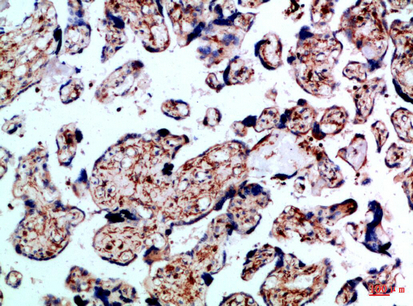BMPR-IB Polyclonal Antibody
- Catalog No.:YT6035
- Applications:IHC;IF;ELISA
- Reactivity:Human;Mouse
- Target:
- BMPR-IB
- Fields:
- >>Cytokine-cytokine receptor interaction;>>TGF-beta signaling pathway;>>Axon guidance;>>Hippo signaling pathway;>>Signaling pathways regulating pluripotency of stem cells;>>Fluid shear stress and atherosclerosis
- Gene Name:
- BMPR1B
- Protein Name:
- Bone morphogenetic protein receptor type-1B (BMP type-1B receptor) (BMPR-1B) (EC 2.7.11.30) (CD antigen CDw293)
- Human Gene Id:
- 658
- Human Swiss Prot No:
- O00238
- Mouse Gene Id:
- 12167
- Mouse Swiss Prot No:
- P36898
- Immunogen:
- Synthetic peptide from human protein at AA range: 21-70
- Specificity:
- The antibody detects endogenous BMPR-IB
- Formulation:
- Liquid in PBS containing 50% glycerol, 0.5% BSA and 0.02% sodium azide.
- Source:
- Polyclonal, Rabbit,IgG
- Dilution:
- IHC 1:50-200, ELISA 1:10000-20000. IF 1:50-200
- Purification:
- The antibody was affinity-purified from rabbit antiserum by affinity-chromatography using epitope-specific immunogen.
- Concentration:
- 1 mg/ml
- Storage Stability:
- -15°C to -25°C/1 year(Do not lower than -25°C)
- Other Name:
- Bone morphogenetic protein receptor type-1B (BMP type-1B receptor;BMPR-1B;EC 2.7.11.30;CD antigen CDw293)
- Background:
- This gene encodes a member of the bone morphogenetic protein (BMP) receptor family of transmembrane serine/threonine kinases. The ligands of this receptor are BMPs, which are members of the TGF-beta superfamily. BMPs are involved in endochondral bone formation and embryogenesis. These proteins transduce their signals through the formation of heteromeric complexes of 2 different types of serine (threonine) kinase receptors: type I receptors of about 50-55 kD and type II receptors of about 70-80 kD. Type II receptors bind ligands in the absence of type I receptors, but they require their respective type I receptors for signaling, whereas type I receptors require their respective type II receptors for ligand binding. Mutations in this gene have been associated with primary pulmonary hypertension. Several transcript variants encoding two different isoforms have been found for thi
- Function:
- catalytic activity:ATP + [receptor-protein] = ADP + [receptor-protein] phosphate.,cofactor:Magnesium or manganese.,disease:Defects in BMPR1B are a cause of brachydactyly type A2 (BDA2) [MIM:112600]. Brachydactylies (BDs) are a group of inherited malformations characterized by shortening of the digits due to abnormal development of the phalanges and/or the metacarpals. They have been classified on an anatomic and genetic basis into five groups, A to E, including three subgroups (A1 to A3) that usually manifest as autosomal dominant traits. BDA2 was described first in a large Norwegian kindred. BDA2 is caused by mutations in BMPR1B gene and studies demonstrate that these mutations function as dominant negatives in vitro and in vivo.,disease:Defects in BMPR1B are the cause of acromesomelic chondrodysplasia with genital anomalies (AMDGA) [MIM:609441]. Acromesomelic chondrodysplasias are rare
- Subcellular Location:
- Cell membrane ; Single-pass type I membrane protein .
- Expression:
- Ovary,PNS,Prostate,
- June 19-2018
- WESTERN IMMUNOBLOTTING PROTOCOL
- June 19-2018
- IMMUNOHISTOCHEMISTRY-PARAFFIN PROTOCOL
- June 19-2018
- IMMUNOFLUORESCENCE PROTOCOL
- September 08-2020
- FLOW-CYTOMEYRT-PROTOCOL
- May 20-2022
- Cell-Based ELISA│解您多样本WB检测之困扰
- July 13-2018
- CELL-BASED-ELISA-PROTOCOL-FOR-ACETYL-PROTEIN
- July 13-2018
- CELL-BASED-ELISA-PROTOCOL-FOR-PHOSPHO-PROTEIN
- July 13-2018
- Antibody-FAQs
- Products Images

- Immunohistochemical analysis of paraffin-embedded Human-placenta, antibody was diluted at 1:100

- Immunohistochemical analysis of paraffin-embedded Human-placenta, antibody was diluted at 1:100



